10 Facts About Public Attitudes Toward Economic Opportunity
Freedom, opportunity, respect, and dignity – just some of the core values that many Americans say define them as individuals and a country. It was these same values that bubbled to the surface in a series of focus groups we held at the beginning of the year in three regions of the country. In collaboration with UnidosUS[1] and Lake Research Partners, we set out to examine how Americans were thinking and feeling directly following the November 2016 election. We found many people united in their concern about the divisive tone of politics and the treatment of people of color, and a shared willingness to act in support of positive change.
This memo draws on the results of this collaborative research project and provides an overview of key findings from a national online dial survey administered to a total of 1,000 registered voters nationwide in March 2017, with oversamples of 100 African Americans, 100 Latinos, and 100 millennials. The margin of error is +/- 3.1 percent for the overall sample and larger for subgroups.
In this memo, we focus primarily on segments of the population defined as the base, opposition, and persuadables[2]. Our base, opposition, and persuadables were created using a statistical cluster analysis that identified groups of like-minded voters based on the patterns of their responses to series of questions about their attitudes toward economic opportunity, diversity, racial inequality, and a variety of related topics. As of March 2017, roughly 33 percent of registered voters made up our base, 17 percent the opposition, and the remaining 50 percent represented persuadable audiences. While these segments correlate to some degree with political party affiliation, they are not entirely predictive of one another. For example, strong Republicans were more likely to fit the profile of persuadable than those who merely lean Republican. More information about the demographics of the base, opposition, and persuadables can be found in the Appendix.
Due to the sample size, we were unable to draw conclusions about three subgroups: Native Americans, those lacking a high school diploma, and those with non-college, post-secondary education. The sample size of each group was too small to make any reliable inferences.
Key findings from our latest analysis include:
1. Americans are united in their concern about the level of respect people in our country have for those from different cultures. Survey participants were asked how concerned they were about the level of respect people have for those from different cultural backgrounds on a scale of 0 (not concerned) to 10 (very concerned). A score of 5 was neutral. The majority of Americans across racial groups, political party affiliation, age groups, and education levels identified as concerned (i.e. reported a concern level of 6 or higher).
Across racial groups, Black Americans and Asian Pacific Islanders were most concerned, with 88 percent of Black Americans and 87 percent of Asian/Pacific Islanders expressing levels of concern 6 or higher. This compares to 83 percent of Latinos, and 79 percent of White Americans. Across political party affiliation, an overwhelming majority of “strong” Democrats[3] (90 percent) expressed high levels of concern about the current level of respect given to people from different cultures, compared to 71 percent of “not strong” Republicans. Across age groups, those under 30 were more likely to express concern than those aged 50-64, with 85 percent of voters under 30 expressing concern, compared to 79 percent of voters aged between 50-64.
2. Persuadables and the base report similar levels of concern over the tone of politics and political conversation. Roughly 87 percent of persuadables and 88 percent of the base reported a level of concern of 6 or higher on a scale of 0 to 10, where 5 was neutral. In contrast, only 67 percent of the opposition reported a similar level of concern.
3. Persuadables express serious concern with their ability to trust the media. When asked how concerned they were about their ability to trust the media, roughly 79 percent of persuadables reported a concern level of 6 or higher on a scale of 0 to 10, where 5 was neutral. In contrast, only 60 percent of the base and 70 percent of the opposition reported a similar level of concern.
When asked specifically about their level of trust in 12 different news sources, persuadables expressed significantly higher levels of trust in friends and family than traditional news media sources. However, persuadables express more trust in sources such as the New York Times, Washington Post, and CNN than right-leaning sources such as Fox News and Breitbart.
4. Persuadables have similar social media habits to the base, and both groups make more use of social media than the opposition. As Figure 2 indicates, the social media habits of persuadables track more closely to the base than the opposition. The most common social media platforms among the base and persuadables are YouTube, Twitter, and Instagram. In addition, persuadables and the base report more social media usage overall than the opposition. Roughly 18 percent of the opposition abstain from social media compared to only 11 percent of the base and 9 percent of persuadables.
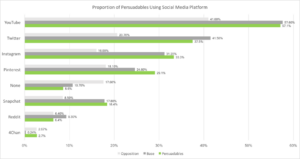
5. In contrast to persuadables and the base, the opposition reports more concern over “opportunity”, less over “inequality”. When asked their views about how serious a variety of topics currently are, a greater proportion of the opposition reports concern over the lack of opportunity (72 percent) than inequality (65 percent). Persuadables and the base not only have higher levels of concern overall, they also show similar levels of concern for both the lack of opportunity and inequality. Ninety-two percent of persuadables and 95 percent of the base reported concern over the lack of opportunity; 95 percent of persuadables and 98 percent of the base reported concern over inequality.
6. Persuadables have conflicting attitudes towards wealth, inequality, and the role of government. Ninety-one percent of persuadables believe that government has an important role to ensure opportunity for all. Further, 58 percent believe that wealthy Americans achieved their success because they had more opportunities rather than because they worked harder. At the same time, 74 percent believe that government assistance created a culture of dependency, and 68 percent believe that turning to government to solve problems will do more harm than good.
7. Persuadables are more likely to support social safety nets when a populist framework focused on the role of wealthy individuals and corporations is adopted. We randomly assigned half of survey participants to respond to the following question:
Which of two statements more closely reflects your views: A) there is “too much focus on helping people who take advantage of government assistance,” or B) the wealthiest corporations and individuals should “pay their fair share”. When framed as an issue of the wealthiest not contributing their fair share, 52 percent of persuadable respondents favored option B and agree that the wealthy should contribute more, compared to 39 percent who favored statement A.
The other half of survey participants were given a similar choice, but option B was modified: A) there is “too much focus on helping people who take advantage of government assistance,” or B) “everyone benefits when we help the people who need it most.” When framed this way, persuadables are more divided on their views, with 49 percent favoring statement A, and 41 percent favoring statement B.
8. Persuadables have conflicting views about people of color, personal responsibility, and discrimination in America. The overwhelming majority of persuadables believe that discrimination against Black Americans (88 percent), Latinos (73 percent), and Muslims (80 percent) is a problem. At the same time, 74 percent believe that “Too often minorities use racism as an excuse for their own failures” and 62 percent believe that “Blacks and other minorities who can’t get ahead in this country are mostly responsible for their own condition”. In contrast, only 27 percent of the base believes “minorities use racism as an excuse”, and only 41 percent believes “minorities are mostly responsible for their own condition.”
9. Persuadables believe strongly in the power of diversity to strengthen, unite, and better our country. Ninety-five percent of persuadables agreed that embracing diversity makes us strong as a country, and 93 percent agreed that it makes us united. Eighty-seven percent agreed that people from different cultural backgrounds make positive contributions to American society. This trend carries across political parties, racial groups, and age groups, with each subgroup responding very positively to diversity and its impact on the country.
10. Persuadables nearly unanimously believe we should counteract bigotry but are skeptical racial attitudes will actually change. Ninety-five percent of persuadables agree that “Everyone should try to do what they can to interrupt bigotry and prejudice,” and that “Everyone should try to do what they can to heal the wounds of bigotry and prejudice.” At the same time, 73 percent agreed that there is nothing “we” can do to change racial attitudes in America, and 74 percent agreed there is nothing “I” ( they personally) can do to change racial attitudes in America.
The overwhelming majority of Americans are excited to mobilize and bring about change. Eighty-five percent of the base is excited to “join together with other people to take action and bring about change.” Similar levels of motivation were reported across political parties, racial groups, education levels, and age groups. However, there was significant variation among education levels and age groups. More education and higher age are both associated with lower levels of excitement.
Audience Considerations
These findings have several implications for galvanizing support and collective action for social justice movements:
- Act now and give clear instructions. The survey strongly suggests that people are eager and ready to mobilize—the question is do they know how? On prejudice, for example, the majority agrees we should do everything we can to counteract it, but some voters remains skeptical that attitudes will change. Giving people concrete actions, or policies to support and explaining the positive impact those actions will have makes it more likely they will engage.
- Keep messaging positive. The majority of survey participants are concerned about the tone of politics and political conversation. Further, they do not trust the media. Leading with the problem is likely to dissuade potential persuadable audiences, who our research shows are currently eager to hear of ways they can positively engage. At a time when trust is low and people are concerned about the spirit of politics, focusing our messaging on the affirmative story and core values we want to uplift is critical to reaching persuadable audiences.
- Empower persuasion among family and friends. At a time when media trust is low, people are turning to family and friends as a source of news and political analysis. Therefore, empowering trusted constituents to move family and friends is an effective way to grow the base.
- Prioritize social media. Persuadables and the base have similar social media habits and use social media at greater rates than the opposition. Thus, communicating through platforms such as YouTube, Twitter, and Instagram is a cost-effective way to reach both the base and persuadable audiences already making heavy use of these platforms.
- Adopt a populist framework. Donald Trump’s successful presidential campaign is a clear indication that the populist framework is currently resonating with a large segment of registered voters. However, our findings also indicate that it is possible to move people toward progressive policy solutions by making use of a populist framework. The survey suggests that people are more amenable to government support of marginalized populations once reminded that government also subsidizes wealthy corporations and individuals. Further, the idea that the wealthy should “pay their fair share” was popular among both base and persuadable audiences, and can be used to encourage support for numerous social justice programs.
- Emphasize strength in diversity. Although survey participants have conflicting attitudes towards people of color, they have consistently positive attitudes toward diversity. The overwhelming majority of persuadables believes that diversity makes America strong and united. Further, they believe that people from diverse backgrounds make positive contributions to society. Advocates seeking to research persuadable audiences should link diversity to strength and problem solving, while also acknowledging that some people might be uncomfortable with change.
APPENDIX
Demographics: Base, Opposition, Persuadables
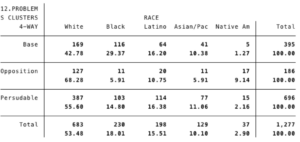
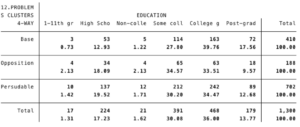
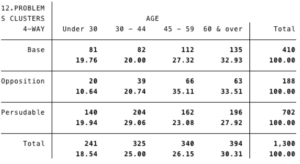
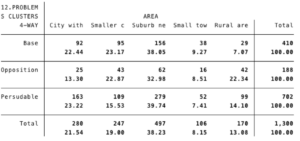
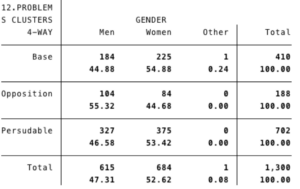
[1] Formerly the National Council of La Raza
[2] Persuadables are individuals who have attitudes that overlap with both the base and opposition. For a full breakdown of their demographic characteristics, see appendix.
[3] Those who strongly self-identified as Democrats.

